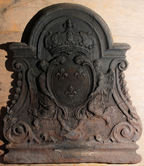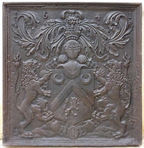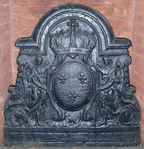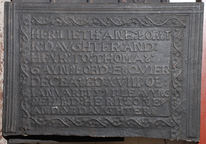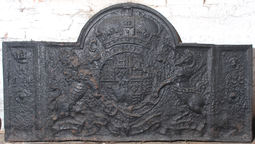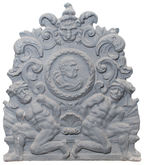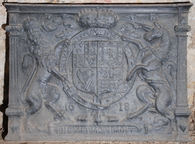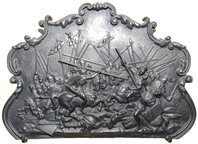-
940
Description: Upon a rectangular base plinth, wide scrolled side fillets with foliage about the scrolls and suspended bell flowers in chain above; central oval shield bearing three fleurs-de-lys supported by an angel on each side, and surmounted by a French royal crown; on top, an arch rising from horizontal moulding on each side.
Notes: Characteristic of designs illustrated by architects such as Daniel Marot.
Arms: France Royal
- Decoration tags:
- rectangular with round arch (shape)
- complex individual (edging)
- whole carved pattern
- planklines
- armorial
- royal
Manufactured: in the late-17th to early-18th century in France.
Current location: not known.
- Attached to series:
- Foreign armorial firebacks
-
1014
Description: Rectangular with moulded edging; shield, forward-facing helm, lion's head crest, mantling, lion supporters, and collar of the Order of St Michael
Notes: The arms are probably those of Jean Bouchu (1597-1653), French parliamentarian: azure, a chevron between, in chief, two crescents and, in base, a lion rampant sinister or.
Inscription: 1641
Arms: Bouchu
- Decoration tags:
- rectangular (shape)
- complex individual (edging)
- whole carved pattern
- armorial
- text
Manufactured: in 1641 in France.
Current location: Claude Augustin Antique Materials, 104 Route Nationale 6, 69380 Les Chères, Rhone, France.
- Attached to series:
- Foreign armorial firebacks
-
828
Description: Upon a rectangular base plinth with an inscribed rectangle, to each side, a wide foliate scroll; central cartouche behind an oval shield bearing three fleurs-de-lys over a horizontally textured ground, supported on each side by a draped male figure, the whole surmounted by a French royal crown; on top, an arch rising from horizontal moulding on each side.
Notes: Characteristic of designs illustrated by architects such as Daniel Marot; the texturing on the shield indicates the azure tincture.
Arms: French royal
- Decoration tags:
- rectangular with round arch (shape)
- complex individual (edging)
- whole carved pattern
- planklines
- armorial
- royal
Manufactured: in the late-17th to early-18th century in France.
Current location: in private hands, Lewes, East Sussex, England.
- Attached to series:
- Foreign armorial firebacks
-
436
Description: Rectangular; carved moulding edging; centre, inscription panel; undulating vine strip stamp repeated thirteen times to form an inner border along each side of the inscription panel.
Notes: The only fireback of the Anne Forster series to have edging formed from wooden moulding probably from dismantled furniture or panelling. Given to the Sussex Archaeological Society in 1850 by Sir Henry Shiffner Bt., of Coombe Place, Hamsey, Sussex. A former occupant of his burnt-out estate cottage, where it had been found, was said to have been a Miss Forster.
Inscription: HER:LIETH:ANE:FORST / R:DAVGHTER:AND: / HEYR:TO:THOMAS: / GAYNSFORD:ESQVIER / DECEASED:XVIII:OF: / IANVARI:1591:LEAVYNG / BEHIND:HER:II:SONES: / AND:V:DAVGHTERS
- Decoration tags:
- rectangular (shape)
- complex individual (edging)
- simple stamps
- carved pattern panels
- planklines
- text
Manufactured: in the late-16th century possibly at Pounsley Furnace, Framfield in the Weald area of England.
Current location: Anne of Cleves House, Southover High Street, Lewes, East Sussex, England.
(part of the Sussex Archaeological Society museum group)
Citation: Dawson, C., 1903, 'Sussex Iron Work and Pottery', Sussex Archaeological Collections, 46, pp. 1-54.
-
449
Description: Arched rectangular shape; cavetto edging; armorial; Stuart English royal arms within a circular garter; crown, motto and supporters (crowned lion and unicorn); initials separated by crown; left rectangular extension panel with double ovolo-moulded edging; top, putto face above initials in triad, with floral patera below; right rectangular extension panel with double ovolo-moulded edging; top, putto face above date, with floral patera below.
Notes: A widely copied armorial fireback with extension panels of a style associated with other date and initial firebacks; the central fireback measures 1080 x 860mm.
Inscription: [central fireback] C [R missing] / ..I SOI T.QVI.MAL.Y. ...SE; [left panel] IRM [triad]; [right panel] 1686
Arms: English Stuart royal
- Decoration tags:
- rectangular with round arch (shape)
- complex individual (edging)
- carved stamps
- whole carved pattern
- individual letters
- individual numbers
- extension panels
- armorial
- royal
- text
Manufactured: in 1686 in the Weald area of England.
Current location: Anne of Cleves House, Southover High Street, Lewes, East Sussex, England.
Museum number: LH000.951 (part of the Sussex Archaeological Society museum group)
-
452
Description: Circular wreathed medallion, bearing the right-facing head of a man in classical dress, carried by two naked, kneeling male figures seated on an elongated pedestal, between them a scallop shell; above the medallion a lion’s face surmounted by a flame; the medallion is surrounded by floral scrolls.
Notes: The wooden pattern would have had a circular aperture (the frame of which is just discernible) for the reception of the medallion; the same pattern was used to cast a fireback bearing the arms of George Worge, and the stamp of the profile was used on an accompanying fireplace side plate (no. 923).
- Decoration tags:
- baroque (shape)
- complex individual (edging)
- whole carved pattern
- pictorial
- humans
Manufactured: in the early- to mid-18th century probably at Robertsbridge Furnace, Salehurst in the Weald area of England.
Current location: Anne of Cleves House, Southover High Street, Lewes, East Sussex, England.
Museum number: LH000.998 (part of the Sussex Archaeological Society museum group)
Citation: Dawson, C., 1903, 'Sussex Iron Work and Pottery', Sussex Archaeological Collections, 46, pp. 1-54.
- Attached to series:
- Baroque series
-
1060
 ? x ? mm
? x ? mmDescription: Central shield bearing a lion rampant reguardant, with esquire's helm and crest of a seated hawk, surrounded by foliage and tasselled ribbons; twisted rope edging at each side; the shape of the fireback is dictated by the decorative elements; initials split by shield, the date similarly split below the initials.
Notes: Drawing of a fireback from old premises, formerly a baker's, opposite 20 Love Lane (later known as Lovat Lane), which ran between Eastcheap and Lower Thames Street; the arms appear to be those of the Morrice family (blazon: gules, a lion rampant reguardant or). Drawn by Charles Raymond Booth Barrett, 1891. A fireback of unique design.
Inscription: W M / 15 86
Arms: Morrice or Maurice
- Decoration tags:
- complex individual (shape)
- complex individual (edging)
- whole carved pattern
- heraldic
- armorial
- text
- plants
Manufactured: in 1586 possibly in the Weald area of England.
Current location: not known.
Museum number: SC/GL/PR/370/LOV/1/q7706298 (part of the London Metropolitan Archives museum group)
Citation: Windyer Morris, G. T., 4 Oct 1902, 'Arms on Fireback', Notes and Queries, 9th series, 10, p. 278.
- Attached to series:
- Date & initials firebacks
-
474
Description: Fragment; arched rectangular shape with rounded corners; ovolo within fillet moulding all round; oval Tudor royal shield with garter surrounding, topped with a royal crown; dragon and greyhound supporters; initials split by crown; inscription on a fillet between legs of supporters, behind garter finial; motto on an Ionic plinth at bottom; left hand rectangular extension panel with twisted rope edging on top and side: initials in top left corner, ‘dragon’s head’ in top right corner, rose-en-soleil stamp in centre, rose stamp bottom centre.
Notes: The letters on the extension panel are the same form and size as those on the top of the armorial pattern, indicating that they were added to the armorial, perhaps to indicate a change of reign. The letter 'E' has also been noted on another fireback of the same series. The rose-en-soleil was the badge of King Edward IV and, thus, a Yorkist symbol; it is seen on other firebacks. From a house in Chailey, Sussex. Illustration from Lower (1849).
Inscription: E R / E / R / HONY SOIT QUE MAL Y PAYNCE / Made in Sussex by John Harvo / DV ET MOVN DR...
Arms: Tudor royal
- Decoration tags:
- rectangular with round arch (shape)
- complex individual (edging)
- carved stamps
- whole carved pattern
- individual letters
- armorial
- royal
- text
- animals
- plants
Manufactured: in the mid- to late-16th century in the Weald area of England.
Current location: not known.
- Attached to series:
- Pounsley series
- John Harvo series
- Rose-en-soleil series
-
519
Description: Rectangular; Ionic pilasters at sides, architrave on top; English Stuart royal shield, garter, crown, motto and supporters; date below and either side of garter.
Notes: One of several firebacks, all of the same date, but varying in size, framing style and moulding; all have stylistic features in common and will have been the work of the same pattern maker, who was also responsible for carving royal coats of arms in three West Country churches. A plaster cast of a fireback of this design is displayed as the royal arms in St George's church, near Abergele in north Wales.
Copies of this fireback are known.
Inscription: HONI SOIT QVI MAL Y PENSE / 16 18 / DIEV ET MON DROIT
Arms: English Stuart royal (James I)
- Decoration tags:
- rectangular (shape)
- complex individual (edging)
- whole carved pattern
- armorial
- royal
- text
Manufactured: in 1618 possibly in the Forest of Dean area of England.
Current location: Penshurst Place, Penshurst, Kent, England.
-
560
Description: Quasi-arched rectangular shape with symmetrical double fillet rococo edging; high relief pictorial battle scene with mounted knights carrying lances and pennants.
Notes: The battle scene may have been inspired by more than one classical portayal of a battle in history; likely sources are 'The Defeat of the Pisans at the Tower of St Vicenzo' by Giorgio Vasari and 'Alexander the Great's crossing of the Granicus' by Charles Le Brun. An engraving by Daniel Kellerthaler (1574-1648) has a similar frame enclosing an unidentified cavalry conflict. Mitford collection, Petworth House.
Copies of this fireback are known.
- Decoration tags:
- baroque (shape)
- complex individual (edging)
- whole carved pattern
- pictorial
- humans
Manufactured: in the late-18th to early-19th century in England.
Current location: Petworth House, Petworth, West Sussex, England.
Museum number: NT/PET/M/54 (part of the National Trust museum group)
- Attached to series:
- Miscellaneous pattern firebacks
